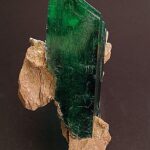What gem is green
A green gemstone is any mineral that exhibits a shade of green. One must-know fact about the topic is that emerald, jade, and peridot are among the most popular green gems. Another fact to consider is that some other stones like tourmaline or garnet may also have shades of green.
How to Identify and Choose Green Gems
As people become more aware of the impact they have on the environment, many are opting for eco-friendly and sustainable options in all aspects of their lives. From clothing to furniture, organic food to transportation – green choices are becoming increasingly popular. Jewelry is no exception.
Green gems are valuable not only because of their beauty, but also because they’re considered ethical and environmentally friendly. While it may seem like an oxymoron that gemstones can be both luxurious and eco-friendly at the same time, we’re here to tell you that green gems do exist! In this blog post, we’ll explore some of the most common types of eco-friendly green gems out there and teach you how to spot them.
First things first – let’s define what makes a gemstone “green.” A truly green gemstone has two distinct qualities: environmental responsibility and human rights protection. Ethically-sourced stones should come from well-managed mines with fair labor practices.
Let’s dive into specifics:
1) Emeralds
Emeralds have been prized for centuries by royalty as symbols of wealth and power due to their deep-green hue. If sourced ethically (as opposed to mining-activities which destroy nature), emeralds can actually help preserve rainforests or other vulnerable land since responsible miners need permission before excavating such areas.
A sure fire way to ensure your emerald is ethically sourced is through certification via Responsible Jewellery Council or Gemfields who oversee sustainability initiatives covering extraction methods including agroforestry agreements where taking trees would reduce forestation change.
2) Peridot
Peridots garners looks effortlessly chic both when used alone or colored gold jewellery piece designs which add dimensionality referencing our love for sunshine tones brighter than yellow ones themselves despite wanting colors less blindingly bright across whole wardrobes every season year round … sound familiar yet? It might just mean sunny Cali / Carmel valley vibes calling
3) Jade
Jade is a fashion favourite which has been used by designers for decades. The gemstone’s durability helps it maintain its shiny lustre and keep chipping to a minimum providing not only responsible sourcing but also an ethical supply chain start-to-finish (even down to where those jewellery boxes come from). Again, going with companies that support transparency in the mining supply-chain of jade is key.
4) Tsavorite
Tsavorites are beautiful green garnets that are rarer than emeralds yet equally as magnificent. This unique type of stone can be found mainly in Tanzania and Kenya, boasting vibrancy levels beyond other greens… color pops louder against metallics such as silver or white-gold so add flare without having to worry about trying out multiple different stones before settling on one perfect match!
The most important thing you should look out for when choosing green gems is their environmental impact. Some lesser-known or less expensive colored stones have undergone synthetic alteration via radioactive treatments, so always ask questions and do your research before purchasing anything like this side-by-side for instance Kyanite mixed along Kingman Turquoise/ possibly Apatite if bundled up under low heating conditions and combined stimulation higher temps again i.e.– finding something genuine takes time while browsing around trying various brand-lines within known big-box shops may help winnow-in on authentic selections over digital repositories alone 📰🔍🛒.
In addition, understanding how these precious stones were obtained allow us an insight into possible human rights violations during sourcing; supporting eco-friendly approved dealerships offers some range of peace-of-mind … so why not delve deeper into right now?!
What Gem is Green in 5 Simple Steps
When it comes to gems, there are numerous options available that can leave you feeling a bit overwhelmed. One way to simplify the process is by focusing on one color group- green. Green gemstones offer a stunning variety of shades and textures, making them perfect for any jewelry piece or occasion.
Here’s how to determine what green gemstone suits your style in just five simple steps:
Step 1: Determine Your Budget
The first step towards picking out your perfect green gemstone is setting a budget. This will help narrow down your selection as certain stones may cost more than others depending on the shape, size and quality of the piece you desire.
Step 2: Identify What Role The Gem Will Play
Will this be an engagement ring? Something for everyday wear or special events? Identifying what role you’d like the stone to play in future outfits will also help narrow down options, such as lighter tones in peridot versus deeper forest greens found in emeralds which could be considered too bold for day-to-day wear.
Step 3 : Educate Yourself About The Types Of Green Gems Available
From vibrant emerald to subtle seafoam tourmaline; some popular types of every shade include jade (known best from Eastern cultures), aventurine quartz(the sparkliest choice)and chrome diopside(less common). Take note at this stage about their uniqueness and research unique-shaped alternatives with appeals similar to theirs such as buying engraved bangle bracelets made traditional agate textured jade-like pieces compared next each other
Step 4: Consider Color Depth
Remembering the seasick neon-green craze during early noughties fashion statement we think twice before choosing even these days when opting colour-matching accessories because colours vary between pale chartreuse or dark almost blue/green hybrids like ‘Paraíba’ tourmaline so consider asking jewelers expert opinion if still unsure.
Step 5: Choose Based On Your Skin Tone
The final step is considering your personal style, as well as what will complement your skin tone. For warmer skin tones focus on emeralds which hold a stronger yellow than traditionally icy-cooler matrix-like gemstones. Those with cooler undertones or paler complexions could look into lighter green quartz halos around sunburst designs for an instant glow.
Remember to trust in the uniqueness of individual stones and it’s better choose feel-good shade preferences over popular mass marketed trends because their sentimentality increases automatically through these choices made with emotional attachment even if imperfection can be found upon closer examination sometimes!
In conclusion, choosing a green gemstone is simpler than you might think: check out budget options, consider color saturation, educate yourself about what kinds are available, decide how much importance this jewellery item holds while reflecting positively with complementary hue shades based on your own tone- then lastly always trust in unique pieces that only resonate when trying them on yourself followed by consideration beyond aesthetics; ensuring lasting memories are preserved accordingly overall.
Frequently Asked Questions About Green Gems
Green gems have become increasingly popular in recent years. They are not only beautiful, but they also carry deeper meanings and symbolic significance. If you’re contemplating purchasing a green gemstone or already own one, there may be some questions lingering at the back of your mind.
In this article, we’ll explore frequently asked questions about green gems to help clear up any confusion you may have.
Q: Which gemstones are considered “green gems”?
A: Green gems include emerald, peridot, jadeite, tsavorite garnet and demantoid garnet, among others. These stones vary in shades from light mint green to deep forest greens.
Q: Are all green gems natural?
A: No. Some sellers market synthetic or lab-grown gemstones as “natural” which can sometimes be difficult for consumers to distinguish between real vs fake stones without expert assistance. Always seek advice before investing large sums on valuable items if uncertain authenticity / provenance exists surrounding them so that you don’t fall prey to counterfeits!
Q: What is the symbolism behind green gemstones?
A: The color green symbolizes growth and renewal in nature which often makes these pieces used for celebrating life’s important moments – think birthdays/anniversaries/weddings etc.. Many cultures believe it signifies good luck; Celtic folklore believed it was an earth goddess’ stone helping stimulate healing & increase feelings of inner calmness while ancient Egyptians dedicated its energies toward fertility regeneration , health & vitality– thus embodying overall optimization across several physical domains beyond just spiritual/emotional realms!
Q: Is there a difference in meaning between different shades of green found within various gemstones such as Jadeite versus Demantoid Garnets?
A: Yes absolutely! Each shade/type does hold unique characteristics that speak beyond color aesthetics alone ( though obviously stunningly portrayed through them). For instance,:
a) While both possess vivid lime-green hues, jadeites are culturally associated with ancient Chinese history and represent traditional symbols of purity, harmony and spirituality. They also have properties that reflect warding off negative energy, promoting wisdom & general emotional tranquility.
b)Demantoid garnets on the other hand while of chlorite-mineral origins portray dark green heavy tones which formerly made them great for being used as jewelry in the Victorian era where luster-heavy pieces were especially fashionable attributes. These stones popularized during such times continue to be worn often at formal events due to their rich tone textures making them a symbol of status, prestige & sophistication.
Q: How do I care for my green gemstone?
A: Green gems should be handled gently due to all their inherent physical qualities (such as hardness/sensitivity) so it’s important that they’re kept clean using appropriate techniques like mild soap or specialized commercial cleaner products sold by jewelers/other retail stores who specialize in stone maintenance etc. Wrap your precious stones/pieces in cloth when storing away safe from direct sunlight/moisture conditions may cause irreversible damage over time – though better yet case properly designed jewelry boxes /holders outfitted with adequate insulation layers preventing inadvertent human-caused bumps.
Now you can feel more confident about your knowledge regarding your precious green gems! There is much beyond just its aesthetic beauty – Its cultural significance throughout time has guided some of our biggest moments as humans seeking deeper spiritual fulfillment within the world . Happy shopping!
Top 5 Facts About the Most Popular Green Gems
1. Emeralds were used as currency in ancient times.
The use of emeralds dates back to approximately 4000 years ago when they were first discovered in Egypt and Columbia. The Egyptians believed that emeralds represented fertility and rebirth, while their splendid hue was also associated with eternal youthfulness. Similarly, Native American tribes considered these gorgeous stones having immense healing power; thus making them exchangeable for goods or other essentials.
2. Jade is revered by Chinese culture
Jade has been valued for thousands of years by China’s society because it represents nobility, purity, good luck, gracefulness and moral excellence. In fact, it was so treasured that an entire dynasty reign era got its name from “Huang jade,” which means “yellow jade.”
3. Peridot is found only rocks created by volcanic activity
Peridots commonly are olive-green-colored gems known for intriguing luminance have few unique characteristics nonetheless categorically mesmerizing one – i.e., These striking beauties usually form within lava; hence they are found exclusively in Hawaii’s beaches! Europeans alternatively label peridot as gemstones representative vibrant hearts representing adventure streak inheriting various shades ranging from yellow-green colour schemes standouts differences amongst green carved stones category babies’ world over favourite playthings lookalikes – spinners fidget toys loved by millions beholding breathtaking captivating sunlight rays reflections upon spinning around their fingers.
4.Turquoise brings protection & tranquillity into your life
Turquoise has long been attributed to bringing calmness into one’s spirit and attracting prosperity too! Ancient medicine practice identified turquoise properties helpful against depression anxiety plus overall well-being-enhancing effects thereby earning moniker possessed unicorns-azure radiance teardrops call deep into oceans vanishing light-visions that ascertains safety and protection to a wearer.
5. Tsavorite has only been discovered in one place – East Africa.
Last but not least, we have tsavorite, which is a vibrant green gemstone found exclusively in Tanzania’s Tanga region! The first specimen was discovered by geologist Campbell Bridges off of Kenya’s historic Tsavo National Park boundary line during the late 1960s exciting adventurers with stories unmatched by any other green coloured stones group members. This stone has managed to remain quite rare; therefore, having it added to your collection means accessorizing using something genuinely special because even now its deposit remains limited elsewhere than those originally identified meaning each piece proves incomparable evidence owning part mankind perspective precious history kept alive through generations hoping for eternity conservation work being sustained countries whose lands give birth sustain nurturing these titanic beauties every day life regalia.
The Importance of Color and Clarity When Choosing a Green Gemstone
As the world becomes more conscious of environmental issues and sustainability, green gemstones have grown in popularity. Their vivid hues evoke a sense of vitality and harmony with nature. But when it comes to making a selection from among various green gems, color and clarity are crucial considerations.
Color is perhaps the most important factor when choosing any gemstone, but this holds especially true for greens. Different minerals create different shades of green—the pale tones of peridot versus emerald’s deep radiant forest effect, or the yellow-green hue of chrysoprase contrasted against jade’s rich minty tone—each having its unique character.
The depth, intensity, and tone must also be considered based on personal preference: light-toned stones may come across as lively while darker gems convey an air of elegance and sophistication.
Clarity refers to how free a stone is from internal blemishes or inclusions that can detract from its appearance or even compromise its integrity. Inclusions can significantly reduce transparency by creating shadows within the stone that dull down its shine; thus reducing the value over time.
It’s always wise to work with reputable retailers whose expertise goes beyond salesmanship so you get genuine advice helping make informed selections.Harsh physical properties help distinguish natural stones from imitation ones like beads strung together becoming difficult to differentiate,&at times carefully crafted fakes masquerade as expensive sparkling treasures—at times leaving first-time buyers at risk.
One such sought after line included Tsavorite garnet—a key player found only insignificantly small deposits originally discovered in Kenya—and Merelani Mint Garnet—discovered much later Tanzania—difficult enough rare finds which experience higher prices if obtained without expert guidance.
While there might be fantastic bargains out there who lowball unacquainted shoppers—however dishonestly traveling long distances visiting remote exotic locales looking for these precious little wands isn’t viable all around. To find one high-quality gemstone could require evaluating ten from the lot and even then exhibiting ample caution in terms of clarity, quality requisitioning specialized tools to do so.
It’s not just about appearances but also aligning expenses with lifestyle choices. Choosing natural uniquely toned green options over material that might have unintentionally caused harm on earth will always radiate one’s intent better than opting for investment sake alone.
In conclusion, whether you’re looking to add some sparkle to an outfit or invest in a timeless piece of jewelry, considering color and transparency when choosing a green gemstone is vital. Stay true to your personal taste while using resources like reputable jewelers who bring trust through extensive industry knowledge helping identify genuinely unique gems—flooding markets sadly at times with fraudulent items or exploited labor—which can offer lasting beauty & good karma simultaneously!
Uncovering the Beauty of Rare and Unique Green Stones
Green stones have an undeniable charm that’s hard to resist. They come in a variety of hues, from the faintest shade of green to vibrant emerald tones. However, not all green stones are created equal. Some are rare and unique treasures that require expert exploration to reveal their true beauty.
One such rare stone is Jadeite – known for its stunningly bright and vivid greens, it was once highly sought after by Chinese royalty as far back as 3,000 years ago. It has been said that jade represents purity, serenity and compassion — making it a symbol of calmness and balance with healing properties.
Another fascinating green gem is Alexandrite – hailed as a natural color-change gemstone that shifts colors depending on the lighting source: bluish-green under sunlight or fluorescent light; purplish-red under incandescent light. Discovered during the time when Tsar Alexander II was ruling Russia hence named ‘Alexandrite’ . This rarity makes Alexandrite one of the most sought-after gems among collectors due to its metamorphic origination- which adds value due to limited areas where it can be mined.
Green Fluorite—less talked about than other popular gemstones but sports an exquisite hue. There lay transparency in those beads which refracts incredible shades ranging between mossy greens and lime blues (often called ‘rainbow fluorites’). Its subliminal significance includes concentration enhancement, clarity stimulation supports better decision-making skills & removes confusion altogether(not bad huh?).
Apergilinite might not sound like your typical precious stone name—but this deep-green opaque crystal half matches any matte dark outfit or simple formal wear! It appears luminous from within without excessive sparkle contributing towards its royal shine , almost so subtle yet awe-striking – reflecting eccentric style choices distinctively .
Tsavorite garnet though semi-translucent elevates basic designs into glamorous ones instantly boasting elegance unmatched -with lush foliage seeming design tint embodied within. The universe’s working created that gorgeous gemstone over a billion years ago, buried deep beneath the surface soon to be excavated and cherished by generations to come—a rare find indeed.
So whether you’re looking to add an exquisite piece of jewelry to your collection or simply appreciate the beauty of unique green stones—take some time in exploring different stones out there: as each one more precious than another.
Table with useful data:
| Gem | Color | Green? |
|---|---|---|
| Emerald | Green | Yes |
| Jade | Green | Yes |
| Peridot | Green | Yes |
| Chrysoprase | Green | Yes |
| Tourmaline | Various colors | Can be green |
| Aventurine | Green | Yes |
Information from an expert: As a gemologist, I can confirm that there are several gems that come in green hues. The most popular and well-known green gem is the emerald, which has a beautiful deep-green color and is highly prized for its rarity and beauty. Another green stone is the peridot, which has a lighter hue of green with yellowish undertones. Jade is also predominantly green in color and comes in various shades like apple green or olive-green. Other less known but equally stunning stones include tsavorite, chrome diopside, and demantoid garnet to name just a few – all ranging from different shades of greens varying from lightest pastels to darkest forest tones.
Historical fact:
Green gems were highly valued by ancient Egyptians, who believed that the color represented fertility and rebirth. The most prized green gemstone among them was emerald, which they associated with their goddess of love and beauty, Isis. The earliest known source of emeralds is in Upper Egypt’s Wadi Sikait region, where mines were active as early as 1500 BCE.
![Uncovering the mystery: what gem is green? [a fascinating story and practical guide with stats and tips] - gulfgemology Green gems](https://gulfgemology.com/wp-content/uploads/2023/05/tamlier_unsplash_Uncovering-the-Mystery-3A-What-Gem-is-Green-3F--5BA-Fascinating-Story-and-Practical-Guide-with-Stats-and-Tips-5D_1683120394.webp)
![Unsocket gems in diablo 2: a guide to solving your socketing problems [with stats and stories] - gulfgemology Gems in diablo 2](https://gulfgemology.com/wp-content/uploads/2023/05/tamlier_unsplash_Unsocket-Gems-in-Diablo-2-3A-A-Guide-to-Solving-Your-Socketing-Problems--5BWith-Stats-and-Stories-5D_1683120395-150x150.webp)
![What gem is for march - gulfgemology Uncovering the mystery: what gem is march? [a guide to birthstones and their meanings]](https://gulfgemology.com/wp-content/uploads/2023/05/what-gem-is-for-march-150x150.png)




